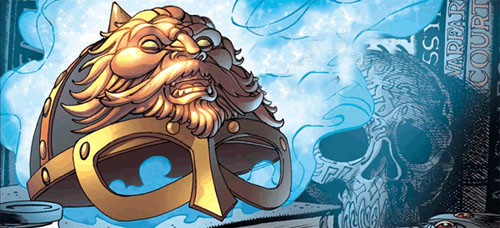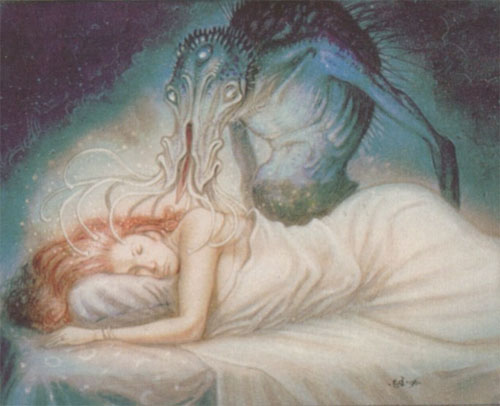As I’ve mentioned a couple times recently, I’m in the process of playtesting some rules for hexcrawling. This is something I’ll probably be talking about in more detail at some point in the near future, but one key element in testing the system was figuring out how do characters move through the wilderness.
In most traditional hexcrawling systems, this question is resolved by navigating the hex map: You move through the wilderness by indicating the next hex you want to go to.
I, on the other hand, specifically wanted to play “hex blind”. I find the abstraction of hexes useful as a GM for mapping and keying a region, but I don’t want the players to “play the abstraction”. But once “I want to go to that hex” was taken off the table, the question became (a) how do you navigate the wilderness and (b) how can we resolve that in an efficient and interesting way? What we slowly hashed out is that people navigate the wilderness by:
- By going in a particular compass direction (“I go north!”)
- By heading towards or following a visible landmark (“We’ll take the road” or “I’ll head toward the mountain I can see on the horizon”).
- By using a map
- By aiming for a familiar destination
- By searching for a location they think is nearby
- By searching a general area looking for anything interesting.
And so forth.
Eventually I figured out that all of this could be mechanically boiled down to two methods:
- Navigation by compass direction
- Navigation by visible landmark
Accompanied by some guidelines on “how you find something” in the wilderness (based on whether it’s a familiar, unfamiliar, or unknown location). So far these core guidelines seem to be covering our bases.
(Of course, this assumes that wilderness exploration is the desired mode of play. If exploration isn’t desired, then there are easier/better ways of structuring a journey from Point A to Point B.)
DUNGEON vs. UNDERWORLD
I mention all this merely as a prelude for my main point of interest this afternoon: Navigating the underworld.
Let me quickly explain what I mean by “underworld” by contrasting it to the traditional “dungeon”.
In a dungeon, the players’ navigation of the environment can be handled in an essentially literal fashion: They see a door and can go through it. They see a hall and can go down it. They see a corner and they can turn it. (This is one of the reasons why dungeons are great for new DMs: They don’t need to worry about framing, transitions, or pacing.)
But this only works in dungeons because there is a certain density of cool stuff within the complex. Poke around a corner or two and you’ll find something interesting to interact with: A monster. A trap. An inscription on the wall. Strange tracks. A magical effect. Whatever.
So by “dungeon” I’m referring to any complex where the density of cool stuff is high enough that navigating the complex “room by room” is interesting. It should be noted that this has nothing to do with the size of the complex: A megadungeon can be very, very large indeed. But it’s still a dungeon, because it rewards that “room by room” method of navigation.
By “underworld”, on the other hand, I’m referring to a complex where the density of “cool stuff” is small enough that “room by room” navigation won’t be rewarding. Consider Moria from Lord of the Rings, for example: It’s a vast complex that takes the Fellowship days to traverse, but in all that time they only find a half dozen or so interesting things. Running that on a turn-by-turn, room-by-room basis would be incredibly boring.
NAVIGATING THE UNDERWORLD
Okay, so let’s pretend that we’re standing at the entrance to an underworld complex. The first question the needs to be asked is, “Why are we going in there?”
- You’re trying to find some specific location within the underworld.
- You’re trying to get through the underworld to the other side.
- You’re following the trail of someone (or something) which has gone in ahead of you.
- You’re just mucking around down there and hoping to find something interesting.
First question: Anything I’ve missed on that list?
Second question: How would you go about doing any of those things? I mean this from a purely in-character perspective, for which a few thoughts occur to me:
- You have a map.
- You generally know that your destination is in a particular direction. (For example, in Lord of the Rings Gandalf knew they needed to head generally east and up to reach the far door.)
- You can follow tracks or other signs.
Other thoughts?
This is all the foundation stuff on which mechanics can later be built. Such mechanics seem to be fairly trivial if you’re willing to remove player agency (“gimme some Dungeoneering checks to see if you find the Golden Crypts”), but more complicated if you want to let the players actually explore the complex by making choices about how they’re proceeding.
Another key element of all this is the handling of transitions to the “dungeon”-type complexes within the underworld. (See Thunderspire Labyrinth or the original D series of modules for a couple different approaches to this sort of underworld exploration.) This seems to be fairly easy if you’re just willing to fall back on the metagame and say, “Okay, you’ve reached the interesting bit.” And then transition back to the more familiar room-by-room sort of thing.
But this can be limiting and jarring. What sorts of things would “naturally” attract greater attention and, thus, provide a more natural transition between exploration modes? Finding recent tracks? Noticing a glint of gold? Encounter creatures?















